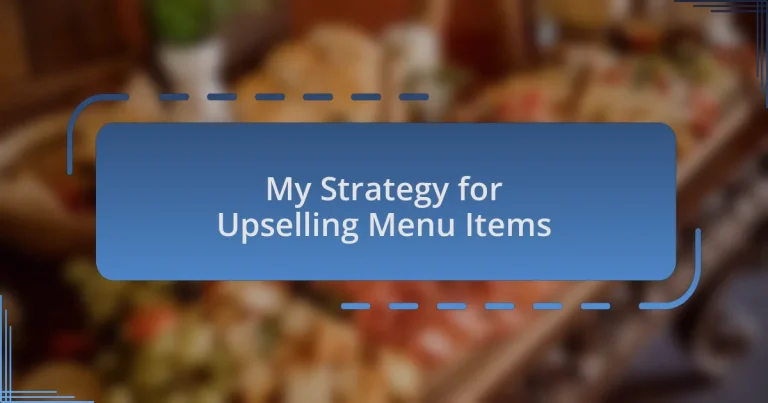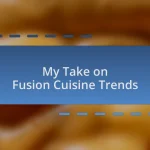Key takeaways:
- Upselling enhances the customer experience by offering personalized suggestions and building connections, leading to increased sales and loyalty.
- Using descriptive language and highlighting exclusivity can effectively drive customer interest and encourage them to try gourmet items.
- Visual presentation and customer testimonials on menus can significantly attract customers and influence their choices.
- Continuous evaluation and adaptation of upselling strategies based on customer feedback and sales data are crucial for success.
Author: Olivia Hartwell
Bio: Olivia Hartwell is a contemporary fiction author known for her compelling narratives and vivid characterizations. With a background in literature and creative writing, she has a keen eye for detail and a passion for exploring the complexities of human relationships. Olivia’s debut novel, Whispers of the Heart, received critical acclaim and was nominated for several literary awards. When she’s not writing, she enjoys hiking in the mountains of Colorado and sipping artisanal coffee at local cafes. Olivia resides in Denver with her beloved rescue dog, Rosie.
Understanding upselling in food trucks
Upselling in food trucks is more than just offering extras; it’s about enhancing the customer’s experience. I remember the first time I served a gourmet burger topped with a unique sauce. I could see the customer’s eyes light up when I suggested pairing it with hand-cut fries and a craft soda. It wasn’t just about the additional sale; it was about creating a memorable meal.
Why do people crave those extra toppings or sides? It’s often linked to the pleasure of indulgence. When I suggest a gourmet aioli for dipping or a special seasonal coleslaw, I watch as customers embrace the opportunity to treat themselves. They appreciate feeling like they’re getting something exclusive, and who doesn’t want to enjoy delicious food with a personalized twist?
Understanding the psychology behind upselling helps in crafting effective strategies. For instance, I’ve noticed that suggesting an upsell after I’ve made a connection with the customer—maybe by chatting about their preferences—leads to higher acceptance rates. It’s all about building a relationship; after all, who wouldn’t want to share their excitement over the perfect meal?
Importance of upselling gourmet items
Offering gourmet items as upsells is crucial for elevating the dining experience. I remember a particular night when a regular customer ordered a classic burger. After a quick chat about her favorite flavors, I suggested a truffle-infused cheese. The delight on her face was priceless, and of course, she couldn’t resist upgrading her order. Moments like these not only boost sales but also deepen customer loyalty.
When customers indulge in gourmet options, they’re not just making a purchase; they’re investing in an experience. I’ve found that many patrons relish the idea of treating themselves, and suggesting an artisanal side can make all the difference. After all, who wouldn’t want to revel in an elevated meal that feels special? This sense of exclusivity can turn a standard meal into a memorable occasion.
The impact of upselling gourmet items extends beyond immediate sales; it fosters a perception of quality. Once, I had a family dine with us, and I suggested a deluxe dessert paired with their meal. They decided to go for it, and their joy when it arrived was a testament to how a well-placed recommendation can enhance satisfaction. This not only encourages repeat business but also positions your food truck as a destination for distinctive culinary experiences.
Techniques for menu item upselling
One effective technique for upselling menu items is to create that personal connection with the customer. I remember a particularly busy day when a couple came by looking for a quick bite. I casually asked if they wanted to enhance their already scrumptious burger with our house-made chipotle aioli. The way their eyes lit up was instant feedback that they were open to the idea, and it ultimately led them to add two sides of our gourmet fries. This kind of personalized suggestion can turn an ordinary meal into something extraordinary.
Another approach is to emphasize the limited availability of gourmet items. For example, I often highlight our seasonal specialties, especially when I’m aware that customers are keen on trying new flavors. One evening, I shared that our limited-edition spicy mango salsa was almost gone for the week. The excitement of knowing they might miss out prompted several diners to add it to their burgers. This fosters a sense of urgency that can effectively drive upsells.
Additionally, training staff to use descriptive language when discussing gourmet items can significantly enhance the upselling process. I once overheard a teammate passionately describing our truffle mayonnaise as “a decadent complement that transforms your burger into a luxurious meal experience.” I noticed a surge of interest when this technique was applied—it’s all about painting a picture that allows customers to envision that delightful taste. Could there be a more enticing way to boost sales than helping customers dream about their next memorable meal?
Creating appealing menu presentations
When it comes to creating appealing menu presentations, visuals play a crucial role. I remember once experimenting with a chalkboard display for our daily specials. The vibrant colors and hand-drawn illustrations caught the attention of passing customers, drawing them in like moths to a flame. Just think about it: how often have you picked a dish simply because it looked so enticing? Presentation can truly make all the difference.
Another technique I find effective is using mouthwatering descriptions. I vividly recall writing a short blurb for our jalapeño bacon burger, describing it as “a spicy, smoky sensation perched atop a juicy patty.” The feedback was immediate—people would come back just to tell me how deliciously accurate that sounded when they finally tried it. Engaging their senses through words can create an irresistible allure that simply can’t be ignored.
Finally, I often incorporate customer testimonials on menu boards. I once displayed a quote from a loyal customer who said, “The garlic aioli made my burger taste like a ticket to paradise!” It intrigued new diners, prompting them to ask about that particular sauce. Isn’t it fascinating how others’ enthusiasm can spark curiosity and lead to upsells? By weaving in these elements into our menu presentations, I’ve seen the impact they have on customer choices—and it’s consistently rewarding.
Leveraging customer interactions effectively
Engaging with customers in a genuine way can significantly enhance their dining experience. I remember a time when I took an extra moment to chat with a customer waiting for their order. We talked about their favorite flavors, and I suggested pairing their burger with our special garlic fries. Their eyes lit up, and they even added a milkshake to their order after our conversation. That personal touch not only made them feel valued but also led to a more satisfying meal and a bigger sale.
Listening actively to customer feedback is another vital aspect of effective interactions. On one occasion, a customer mentioned they were craving something extra spicy. I took that opportunity to introduce our new spicy barbecue sauce, describing how it complements the smoky flavor of the beef. Their excitement in trying something new fueled my passion for creating memorable experiences. Have you ever noticed how a customer’s interest can turn an average meal into a true culinary adventure? Turning their wants into offerings not only boosts sales but fosters loyalty, as they feel heard and appreciated.
Lastly, follow-up interactions can be a game changer. After a busy weekend, I made it a point to message frequent customers who had commented on our social media about missing a popular dish. I invited them to the truck for a special engagement night where that item would be featured. It was heartwarming to see them return, excited and grateful for the heads-up. These moments of connection emphasize that upselling isn’t just about increasing sales; it’s about cultivating relationships that keep customers returning for more.
Personal experiences with upselling
Upselling has often felt like a balancing act for me, but I’ve had rewarding moments that really highlight its potential. One busy afternoon, I noticed a family scrutinizing the menu while trying to choose a meal. I casually mentioned our gourmet burger topped with truffle aioli, and they all leaned in, clearly intrigued. It turned into a lively discussion about flavors, and by the end, they had not only chosen the burger but also opted for a side of artisan pickles. That satisfaction on their faces is what I aim for with upselling—it’s about igniting that spark of excitement.
I’ve also realized that upselling can go beyond just the food menu. During one busy evening, I saw a couple enjoying their meal, and I could sense they were celebrating something special. I took a moment to bring them our dessert menu, highlighting the chocolate lava cake, and shared how customers rave about its rich flavor. It was heartwarming to see their eyes light up, the decision felt personal, and I felt like I played a small part in enhancing their celebration. Isn’t it amazing how an extra suggestion can turn a good meal into an unforgettable moment?
The power of upselling truly shines when you personalize it based on relationships. I had a regular who always ordered the same spicy burger. One night, I suggested trying our new avocado salsa on top. When they experienced the burst of flavors, they couldn’t stop smiling. It made me think, how often do we miss opportunities to elevate the dining experience simply by being attentive? Seeing them return the next week, excited to again try something new, reinforced the idea that upselling, at its core, is about enhancing customer joy and connection.
Evaluating upselling success and adjustments
Evaluating the success of my upselling strategies requires a keen eye on customer reactions and sales data. I remember one busy weekend when I noticed a spike in requests for our specialty sauces after promoting them with several burgers on the menu. This wasn’t just a lucky coincidence; it indicated that my approach to recommending gourmet additions resonated with customers and enhanced their overall experience. Have you ever looked back on a small suggestion that turned out to be a big win?
On another occasion, I found that pushing a combo deal for fries and drinks didn’t yield the results I expected. Despite my enthusiasm, customers seemed unresponsive. It was a moment of reflection—this wasn’t just a sales tactic, it needed to feel like a fulfilling choice for diners. I quickly reconsidered my pitch, deciding to engage more with customers about what they were looking for instead. Isn’t it fascinating how an adjustment in approach can lead to entirely different outcomes?
Through these experiences, I’ve learned to adapt based on what truly matters—customer satisfaction. Keeping track of sales after upsell attempts allows me to refine my methods continuously. What worked well last week might not strike the same chord today, and that’s okay. Each interaction is a chance to learn and grow, turning upselling into a more personalized experience. Wouldn’t it be great if every suggestion we made left our customers smiling, wanting to return?


